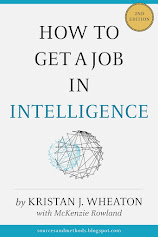One doesn't often find an academic critique of a US Army Field Manual but that is exactly what recent Mercyhurst graduate Brian Gabriel set out to do in his thesis, "Evaluating The Transferability Of Counterinsurgency Doctrine: From The Cold War To Global Insurgency".
In this instance, Brian's target was FM 3-24, Counterinsurgency. In general, Brian was seeking to explore the "transferability" of the US's new doctrine: Would this doctrine work with respect to future conflicts in new geographical locations at any scale or was it designed, as new doctrines sometimes are, to win the "last war"? Brian was specifically trying to determine if "the new doctrine truly provides a framework to defeat insurgencies around the world regardless of the nature of the insurgency or if the doctrine’s utility is more limited."
Brian does many of the usual things you would expect to see in a thesis such as this and does them well. His literature review, for example, covers the history of US counterinsurgency doctrine, the genesis of the new doctrine and the critiques of that doctrine in a well-written and interesting way that contains enough detail without coming across as overwhelming.
Brian then uses the precepts that underlie the manual and the criticisms of the manual as a jumping off point for his own analysis based on "a total of seven insurgencies, from Malaya to Somalia, and the approaches of counter-insurgent forces from three countries—Great Britain, France, and the United States. In addition, the transferability of FM 3-24 was evaluated through the use of two methodologies, one theoretical and another providing real-world perspective."
Brian uses a nifty matrix to capture and display the results of his analysis. I have included a reduced size version of the matrix with this post but it is really worth the effort to download the full thesis and walk through Brian's dissection not only of the FM but also of its critics.
Ultimately Brian finds, "Despite the critiques of some counterinsurgency theorists, FM 3-24 has a high level of transferability. The transferability of FM 3-24 is not limited by a change in the geopolitical environment, a shift in the motivations of insurgents, the presence of third-party counter-insurgents, nor other characteristics that differentiate insurgencies today from the twentieth century. This means that the doctrine’s precepts—the balance of offensive, defensive, and stability operations, the importance of intelligence-driven operations, the necessity of training host nation security forces, etc—remain valid in a post-anti-colonial era. This result, however, only applies to domestic insurgencies. Serious questions emerge about the doctrine when it is applied to regional or global insurgencies."
If you are interested in counterinsurgency operations at all, it is worth a look. You can download the full text here.





